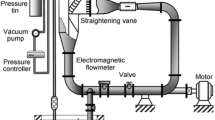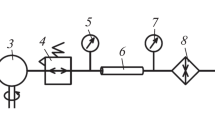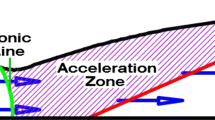Abstract
The experimental and numerical investigation of unsteady cavitating flow around a NACA2412 hydrofoil with chemically treated surfaces is described. The study was focused on the influence of the surface wettability on the intensity of cavitation processes. Two steel hydrofoils whose surface is treated using different methods are compared with a hydrofoil having a nontreated surface. The first of the treated hydrofoils has a 50–70-µm thick wear-resistant hydrophobic coating of tungsten carbide applied by ion-plasma deposition in a vacuum chamber. The second hydrofoil has a coating of a surfactant, octodecyamine, applied by deposition while keeping the hydrofoil in an aqueous solution. The hydrofoil with the span/chord ratio of 1.25 was tested in the cavitation tunnel. The incidence angle of the hydrofoil to the incoming flow was 8°. Numerical results were obtained using the ANSYS CFX software package with the Zwart cavitation model and the SAS-SST turbulence model. The monitored pressure fluctuations and the level of noise generated by cavitation-induced unsteady processes are estimated. It is demonstrated that additional surface treatment can help prevent unwanted phenomena in the flow path caused by cavitation. This technique does not require expensive modernization of the flow path in hydraulic machines. Numerical simulations and experiments carried out by the authors suggest that surface treatment can considerably affect the cavitation processes, and the results of studies demonstrate the need for further in-depth investigation of cavitation processes in hydraulic machines, including with the use of modern application software tools.
















Similar content being viewed by others
Notes
The first natural frequency is the oscillation frequency of a conservative system, which is determined only by the system’s own characteristics (in this case, the blade profile and the parameters of the test section when interacting with the flow.
The dominant oscillation frequency is the frequency at which the frequency composition of the oscillation waves coincides with the amplitude-frequency characteristic of the acoustic layer.
Test of the surfactant-coated hydrofoil without exposure to water; two tests after prolonged exposure to water for several weeks: the second and third experiments.
REFERENCES
Y. A. Bouziad, Physical Modelling of Leading Edge Cavitation: Computational Methodologies and Application to Hydraulic Machinery, Thesis No. 3353 (École Polytechnique Fédérale de Lausanne, Lausanne, Switzerland, 2005). https://doi.org/10.5075/epfl-thesis-3353
Y. Tsujimoto, H. Horiguchi, and K. Yonezawa, “Cavitation instabilities in turbopump inducers. Analyses in 1–3 dimensions,” Int. J. Fluid Mach. Syst. 3, 170–180 (2010).
M. Sedlář, M. Bajorek, and J. Šoukal, “Investigation of cavitation phenomena in suction part of radial-flow pump,” in Proc. 7th Eur. Conf. on Turbomachinery, Athens, Greece, Mar. 5–9, 2007 (National Technical Univ. of Athens, Athens, 2007), pp. 785–794.
M. Sedlář, O. Šputa, and M. Komárek, “CFD analysis of cavitation phenomena in mixed-flow pump,” Int. J. Fluid Mach. Syst. 5, 18–29 (2012). https://doi.org/10.5293/IJFMS.2012.5.1.018
M. Sedlář, B. Ji, T. Krátký, T. Rebok, and R. Huzlík, “Numerical and experimental investigation of three-dimensional cavitating flow around a straight NACA2412 hydrofoil,” Ocean Eng. 123, 357–382 (2016). https://doi.org/10.1016/j.oceaneng.2016.07.030
M. Sedlar, J. Soukal, M. Komarek, A. V. Volkov, and A. V. Ryzhenkov, “Numerical simulation of interaction between fluid and vapor structures in multiphase flow around hydrofoil,” J. Appl. Math. Phys. 6, 1614–1624 (2018). https://doi.org/10.4236/jamp.2018.68137
V. Belova, D. A. Gorin, D. G. Shchukin, and H. Möhwald, “Controlled effect of ultrasonic cavitation on hydrophobic/hydrophilic surfaces,” ACS Appl. Mater. Interfaces 3, 417–425 (2011). https://doi.org/10.1021/am101006x
T. Lyubimova, K. A. Rybkin, O. Fattalov, and L. Lorraine, “Dynamics of vapor-gas bubbles in a liquid near solid surfaces with different properties,” IOP Conf. Ser.: Mater. Sci. Eng. 581, 012041 (2019). https://doi.org/10.1088/1757-899X/581/1/012041
A. S. Aghdam, M. Ghorbani, G. Deprem, F. C. Cebeci, and A. Koşar, “A new method for intense cavitation bubble generation on layer-by-layer assembled SLIPS,” Sci. Rep. 9, 11600 (2019). https://doi.org/10.1038/s41598-019-48175-4
D. Jasikova, M. Kotek, M. Muller, and V. Kopecky, “Single cavitation bubble interaction close to hydrophobic surface,” Int. J. Mech. 11, 73–81 (2017).
Y. Zhu, M. Shan, Y. Yang, Q. Han, Ch. Zhu, and X. Zhang, “Effect of wettability on collapsing cavitation bubble near solid surface studied by multi-relaxation-time lattice Boltzmann model,” Appl. Sci. 8, 940–951 (2018). https://doi.org/10.3390/app8060940
P. Gregorčič, P. Šetina-Batič, and M. Hočevar, “Controlling the stainless-steel surface wettability by nanosecond direct laser texturing at high fluences,” Appl. Phys. A 123, 766 (2017). https://doi.org/10.1007/s00339-017-1392-5
M. Petkovšek, M. Hočevar, and P. Gregorčič, “Cavitation dynamics on laser-textured surfaces,” in Proc. 10th Int. Symp. on Cavitation (CAV2018), Baltimore, USA, May 14–16, 2018 (American Society of Mechanical Engineers, New York, 2018). https://doi.org/10.1115/1.861851_ch39
M. Petkovšek, M. Hočevar, and P. Gregorčič, “Surface functionalization by nanosecond-laser texturing for controlling hydrodynamic cavitation dynamics,” Ultrason. Sonochem. 67, 105126 (2020). https://doi.org/10.1016/j.ultsonch.2020.105126
M. Williams, E. Kawakami, E. Amromin, W. Hambletonand, and R. Arndt, “Effects of surface characteristics on hydrofoil cavitation,” in Proc. 7th Int. Symp. on Cavitation (CAV2009), Ann Arbor, Michigan, Aug. 17–22, 2009.
K. Onishi, K. Matsuda, and K. Miyagawa, “Influence of hydrophilic and hydrophobic coating on hydrofoil performance,” in Proc. Int. Symp. on Transport Phenomena and Dynamics of Rotating Machinery (ISROMAC), Maui, Hawaii, Dec. 16–21, 2017.
T. Mineshima, K. Onoshi, and K. Miyagawa, “Flow field and cavitation characteristics of hydrofoils coated with hydrophilic and hydrophobic polymers,” IOP Conf. Ser.: Earth Environ. Sci. 240, 062055 (2019). https://doi.org/10.1088/1755-1315/240/6/062055
J. Hao, M. Zhang, and X. Huang, “Experimental study on influences of surface materials on cavitation flow around hydrofoils,” Chin. J. Mech. Eng. 32, 45 (2019). https://doi.org/10.1186/s10033-019-0355-5
J. Kim and J. S. Lee, “Numerical study of cloud cavitation effects on hydrophobic hydrofoils,” Int. J. Heat Mass Transfer 83, 591–603 (2014). https://doi.org/10.1016/j.ijheatmasstransfer.2014.12.051
M. Sedlář, P. Zima, and M. Müller, “CFD analysis of cavitation erosion potential in hydraulic machinery,” in Proc. 3rd IAHR WG Meeting, Brno, Czech Republic, Oct. 14–16, 2009, pp. 205–214.
P. Zima and M. Sedlář, “Modeling bubble collapse aggressiveness in traveling bubble cavitation using bubble breakup model,” in Proc. 8th Int. Symp. on Cavitation (CAV2012), Singapore, Aug. 13–16, 2012, No. 209, pp. 182–186.
A. V. Volkov and S. N. Pankratov, “Ways to improve the performance of pumping equipment for thermal power facilities,” in Hydraulic Machines, Hydraulic Drives, Hydropneumatics: Proc. 3rd Int. Sci.-Tech. Conf., St. Petersburg, Russia, 2005, pp. 82–89.
A. V. Volkov, G. P. Khovanov, and S. A. Chernyshev, “Investigation of the hydrodynamic interaction of a hydrophobized surface with a working flow using the example of a flow around a plate,” in Efficiency and Environmental Friendliness of Pumping Equipment: Proc. Int. Sci.-Tech. Conf. (ECOPUMP.RU 2007), Moscow, Russia, 2007, pp. 15–16.
A. V. Ryzhenkov, S. I. Pogorelov, A. V. Kurhakov, M. A. Morozov, and N. V. Ryzhenkova, “Prospects for the application of film-firming amines in power engineering,” in Proc. Surface Effects and Contact Mechanics including Tribology XII: Computational Methods and Experiments (WIT, Southampton, U.K., 2015), in Ser.: WIT Transactions on Engineering Sciences, Vol. 91, pp. 127–137. https://doi.org/10.2495/SECM150121
R. N. Wenzel, “Resistance of solid surfaces to wetting by water,” Ind. Eng. Chem. 28, 988–994 (1936). https://doi.org/10.1021/ie50320a024
Funding
This work was supported by Ministry of Education, Youth, and Sport of the Czech Republic [grant no. CZ.02.1.01/0.0/0.0/17_049/0008408 of the Hydrodynamic Design of Pumps project]. The presented results were also obtained with the financial support of the Ministry of Science and Higher Education of the Russian Federation under assignment no. FSWF-2020-0021 “Development of Scientific and Engineering Fundamentals for Enhancement of Condensation Heat Transfer and Improvement of Thermohydrodynamic Characteristics and Wear Resistance of Power Equipment Based on the Modification of Functional Surfaces.”
Author information
Authors and Affiliations
Corresponding authors
Additional information
Translated by T. Krasnoshchekova
Rights and permissions
About this article
Cite this article
Sedlář, M., Komárek, M., Šoukal, J. et al. Experimental and Numerical Studies into the Cavitation Impact of the Hydrofoil Surface with Different Treatments. Therm. Eng. 69, 418–428 (2022). https://doi.org/10.1134/S0040601522060064
Received:
Revised:
Accepted:
Published:
Issue Date:
DOI: https://doi.org/10.1134/S0040601522060064




